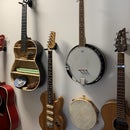Introduction: Liturgical Calendar (wooden or Printable)
A friend of mine had been living with another friend who was an Anglican priest and as a leaving gift, he wanted to make him a giant liturgical calendar from a endgrain slice of wood.
So we set out to make a liturgical calendar that could work from year to year and still match up the dates.
This instructable has instructions on how to make your own wooden one, but also includes the download files for a printable one that you can easily print off, laminate and stick on your wall.
Step 1: Designing the Calendar
The first step of any project is to figure out how it will work. I generally use Inkscape for this process because I can chuck all my ideas in one space and quickly and easily make changes to the idea.
I used a photo of the wood with a ruler, so that I could size the design up to fit the ring of wood that I had.
I generally do my first idea, then I duplicate it five times and try come up with about 5 other ways of doing it. Then I compare and contrast to see what problems each idea might have.
The inkscape file is attached.
This lectionary calendar was for a friend who is an Anglican priest, so the dates are based around the litergy of the Anglican Church of Aotearoa New Zealand.
I settled on the idea of having a calendar with all the main dates fixed (ie. Christmas is the 25th of December) and then a section of the calendar that moves (ie. Lent through to Transfigeration Sunday). I also made a small arrow that would change Christ the King Sunday.
I've included a PDF version so that you can print one off and laminate it rather than building a giant wooden one.
All the colours on the calendar are colours traditionally worn on the robes of Anglican priests on those dates (although there is some variance).
Attachments
Step 2: Wood Prep
So we cut some rings of wood for the calendar. We cut them with a chainsaw. They were about 4cm thick each.
The trouble was that we were wanting to complete the project in a month as a gift, and the tree rings had only recently been cut, so the wood was wet. We knew it would split as it dried, so I came up with an idea to reinforce it. I routed out a slot on the back and glued some plywood in to help hold it together as it dried. This came with a major oversight. Wood shrinks as it dries. This meant that as it dried, the plywood rather than reinforcing things, worked more like a wedge and it split it further apart. A year on, the calendar is pretty split apart and the spare rings without any reinforcing are still held together reasonably well. I think the 4cm thickness of the rings means that they dry relatively fast and relatively evenly.
The other part of the job was just heaps and heaps of sanding. I spent a few hours on a rough grit belt sander getting all the chainsaw marks out of the wood and then with a finer grit, kept sanding to bring out the grain.
Step 3: Transferring the Design
I love doing this. Basically print your design in reverse on a photocopy machine, and then iron it on. You need a big printer that uses toner, because it heats the ink to the paper and you can then heat the ink back off again.
I've found that I get the strongest results with my wood burning iron, but you can use a clothes iron on it's hottest settings. I like to tape or pin my design on, iron and then gently lift it to see how well it worked. Then I go over any missed spots and go again. As you can see on the photos, I was tearing the paper off as I completed each section. This helped me to keep track of where I was up to and to avoid moving the templates too much.
Step 4: Assembly
So, there were a few things to assemble. I decided to add small dowels that sit out over the dates to make it clearer. Each one of them was painted litergical colours on the ends and then holes were drilled to insert them into the edge of the Lent-Transfiguration layer. I also drilled holes for all the other dates and inserted a short dowel with the colour for that date.
The Lent-Transfiguration layer was then bolted on to the calendar with a large screw from the back.
I then made a small arrow that pointed out Christ the King Sunday. This pivoted from a dowel.
And that's it!

Participated in the
Home Decor Contest












